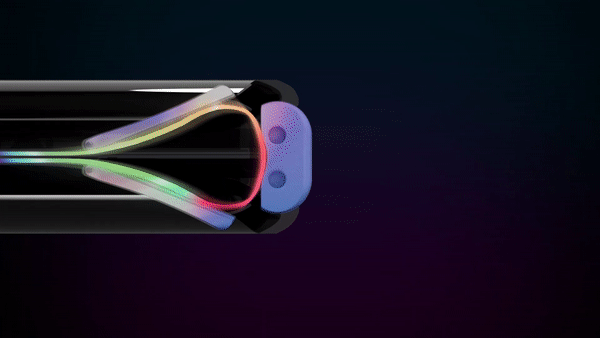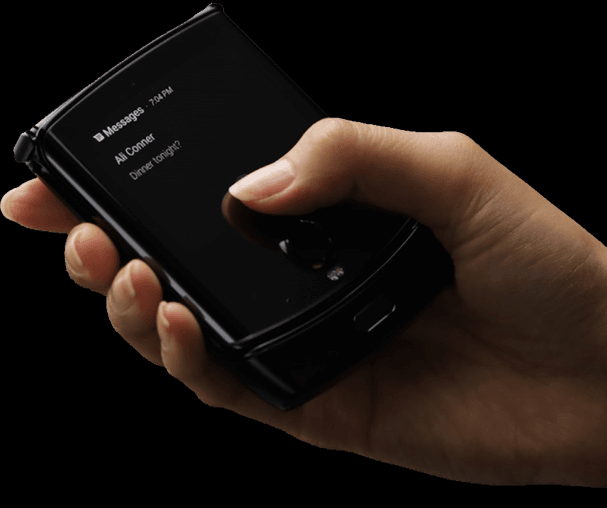Following a decade of seeing black, rectangular glass slabs grow in size while swapping their backs between metal and glass, foldables are taking over to become the face of phone fetish. With the nostalgia-invoking Motorola Razr set to go on sale about a week before the Galaxy Z Flip’s unveiling, it’s about time we put the two face-to-face and see which one deserves your dough.
Flippity-floppity form factor
The fad of the early ’00s, flip phones are making a comeback, bringing along the gratifying sound of snapping them shut, although in a more contemporary avatar. While both the Motorola Razr and Galaxy Z Flip have a similar clamshell form factor, you can immediately recognize them apart, thanks to their distinct design approach.
Top: Motorola Razr, Bottom: Samsung Galaxy Z Flip
Samsung’s offering will seemingly carry the DNA of a modern smartphone and wouldn’t look vastly different when in the unfolded state. You’ll get the usual nearly edge-to-edge display with a hole-punch camera and chunky bezels. The Motorola Razr, on the other hand, clearly strikes the nostalgic chord with a layout borrowed almost as is, complete with a chin, from the original Razr that had an alphanumeric keypad.
Samsung Galaxy Z Flip - First Hands On Video pic.twitter.com/4b8Uzt5kRB
— Ben Geskin (@BenGeskin) February 2, 2020
In a hands-on video that surfaced recently, the Z Flip appears to have a rather unwieldy design, particularly when it’s unfolded. That display is tall to a fault and might even work against the device. The phone seemingly gets more manageable when closed into a square with a tiny screen on the outside. Motorola’s flip phone, instead, has a smaller footprint, which helps it fit your hand better in either state.
What’s with the chin? And that hinge?
Left: Razr’s chin, Right: Galaxy Z Flip’s two halves
The original Razr's raised chin was an iconic design element that the re-engineered foldable version retained to draw parallels as well as include additional functionalities. For one, it houses a user-facing capacitive fingerprint reader along with speakers grills and a USB-C port at the bottom. At 14mm, the chin is the thickest point, while the rest of the slab is merely 6.9mm when unfolded.
The Z Flip looks to have a more uniform thickness (barring the camera bump) of 6.9mm when wide open. When folded, it could be a couple of millimeters thicker around the hinge, forming a wedge shape. Though, it’ll still fold into two halves, unlike Motorola’s asymmetrical implementation. Its fingerprint scanner will likely be embedded in the side-mounted power key as the 2019 Galaxy Fold had.
Top: Motorola Razr’s hinge in action. Bottom: Galaxy Z Flip’s hinge when folded.
The hinges used by Motorola and Samsung are like chalk and cheese, which also affects how visible the display crease would be. Razr’s hinge uses a pair of support plates (shown above) to brace the display from underneath, which helps make the crease imperceptible. It, along with a sliding screen, folds the phone completely shut, unlike the first-gen Samsung Galaxy Fold's ridge, which leaves a wedge-shaped gap.
We aren’t sure if the Z Flip will inherit that cavity, since none of the leaked images, including the recent renders from Roland Quandt, have shown the phone’s folded side, though the varying thickness mentioned above clues in on its presence, and so does the video above. Samsung is expected to use a redesigned juncture that will hold the phone’s flexible screen at any angle you like, while the Razr only supports two furthest positions: open and shut. However, it won’t help in hiding the crease, which might remain as noticeable as its predecessor.
Big foldable display and small sidekick
Flip phones are anything but new; in fact, they’ve been around for decades. It’s the flexible displays that rebounded their relevance in 2020. Both the Razr and Z Flip sport a bendable OLED screen that folds inwards along the X-axis, like a traditional clamshell phone. That’s precisely where the similarities end and the two phones part ways.
The Motorola phone features a 21:9 6.2-inch P-OLED with a resolution of 2,142 x 876 pixels. At the same time, the Z Flip is rumored to include a bigger 6.7-inch AMOLED (2,636 x 1,080, 22:9) covered with an ultra-thin glass—possibly the first-ever foldable glass display—instead of plastic. Plus, Samsung will opt for a hole-punch front camera against Razr’s notch.
Left: Razr’s secondary screen, Right: Galaxy Z Flip’s
A secondary display accompanies the main one on both phones, but their sizes and functions differ wildly. The one on the Razr is significantly larger at 2.7 inches (600 x 800, 4:3), while Samsung is said to include a 1-inch display (300 x 116) with minimal functionality. The bigger screen not only shows you more information without having to flip the phone open but can also work as a viewfinder for selfies, besides having other features.
On the inside
What powers the Motorola Razr is a mid-tier Snapdragon 710 processor paired with 6GB of RAM and 128GB of onboard storage. Samsung’s choice of processor, on the flip side, will possibly be the higher-end Snapdragon 855+. It’ll also throw in 256GB of storage as well as 8GB of RAM. The Z Flip should run Android 10 with Samsung’s One UI 2.1 skin on top, while the Razr offers a near-stock OS experience with Android Pie along with a retro mode to give you an ancestral throwback.
Razr’s retro mode (via The Verge)
With that kind of configuration, the Razr doesn’t stand a chance against the upcoming (or even existing) breed of mainstream smartphones boasting the Snapdragon 865, not that it’s even trying to, but the Z Flip still looks better equipped. That razor-thin form factor largely dictated Motorola’s choice of rather mediocre, not to mention old, chip, just so it could keep heat dissipation and battery drain in check.
Cameras
Similar space constraints kept the Lenovo-owned brand from adding anymore camera than the current two—one each on the inside and outside. The Razr has a 16MP primary camera that can shoot 4K videos and be used for taking selfies when the phone is folded. The one in the notch has a 5MP sensor capable of taking 1080p videos. Leaks suggest that the Galaxy phone will have a pair of 12MP cameras on the back along with a 10MP front-facing one—all three of these could be borrowed from the 2019 Samsung flagships. Its secondary display isn’t likely to double up as a viewfinder, given its tinier footprint.
Left: Razr’s primary camera, Right: Galaxy Z Flip’s two rear cameras
Battery juice
In the battery department, the Z Flip might take the lead with a rumored capacity of 3,300mAh, while the Razr settles for a much smaller 2,510mAh. However, both can charge using a 15W brick. Despite a smaller cell, Motorola is aiming for a day’s worth of juice, but it remains to be seen how the Razr sails through a typical workday, and also possibly when put up against the Samsung foldable. The Samsung phone may have the upper hand in this department with support for wireless and reverse wireless charging.
Pricing and availability
Those in the US will need to shell out $1,500 for the Motorola Razr or $63 a month for a 24-month contract with Verizon. The demand for the novel handset was apparently sky-high, leading the company to push the release date back by a month. After having preordered the handset starting January 26, you can pick it up on February 6.
On the other hand, Samsung is expected to make the Z Flip official alongside the S20 line at the Unpacked event on February 11. As for its pricing, two opposed figures have so far been thrown around. One report said it could cost close to $860, while the other quoted $1,550—almost double the former. You should expect an asking price somewhere between the two figures, inclining towards the latter.
Everything else
A nanocoating on the Motorola Razr should make the device splash-proof, but dunking it in water is still a big no-no. Nonetheless, it’s a considerable feat for a foldable phone that has moveable parts in and around the hinge, which cannot be sealed. That’s possibly the reason Samsung will likely skip any form of water resistance. Besides, the Razr can only take an eSIM as there is no SIM card tray, which the Z Flip might have, in line with the Galaxy Fold.
The Samsung phone is also expected to pack stereo speakers, likely pairing the single down-firing unit with the earpiece. It’s worth noting that neither phone has a headphone jack, nor do they support 5G or have 5G-capable variants, and thankfully so. We can only imagine the number of times you’ll be required to plug them in with their unconvincing battery situations if they tried latching onto a 5G network.
At this point, we’ll not be giving a final statement on which phone outweighs the other, or our recommendation for that matter, given that the Galaxy Z Flip isn’t out yet, and all its included details are courtesy of leaks and rumors. We’ll update the coverage when we get an official word from Samsung along with the pricing details.
https://news.google.com/__i/rss/rd/articles/CBMiUGh0dHBzOi8vd3d3LmFuZHJvaWRwb2xpY2UuY29tLzIwMjAvMDIvMDQvc2Ftc3VuZy1nYWxheHktei1mbGlwLXZzLW1vdG9yb2xhLXJhenIv0gFUaHR0cHM6Ly93d3cuYW5kcm9pZHBvbGljZS5jb20vMjAyMC8wMi8wNC9zYW1zdW5nLWdhbGF4eS16LWZsaXAtdnMtbW90b3JvbGEtcmF6ci8_YW1w?oc=5
2020-02-04 14:55:00Z
52780586928661











Tidak ada komentar:
Posting Komentar